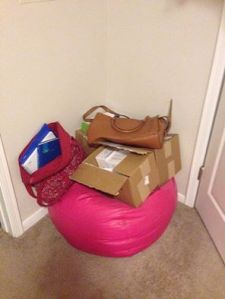My apartment could easily get selected for a TLC special entitled Hoarders: The Diabetes Edition. I have mountains of old supplies stocked up just in case the apocalypse ever occurs and I for some reason need a 6-year-old infusion set for an insulin pump that I no longer utilize… (Note: Proper medical guidance instructs never to use expired supplies. I am in no way recommending that you do so.)
I have trouble discarding diabetes supplies because they represent my lifeline, even if they are expired. The thought of running out of supplies freaks me out. Temporary relief arrives when my mail order pharmacy prescriptions knock at my front door, providing life in predetermined 3-month packages per my insurance provider. But what if I drop and shatter a vial of insulin accidentally? I may need my fridge stockpile to get me through until my next order. Most of us are privileged enough to obtain medication through various means, however much of a longwinded telephone loop-de-loop headache that process may render. If we lived somewhere else or during some other time, we may not have been able to count these blessings. My bedroom’s diabetes supply closet is a constant reminder of this privilege.
There are certain items that I can’t bring myself to throw out, but probably should. I returned to multiple daily injections in December after going through the hardest time of my life- a period in which the only type of infusion set that would work with my body type just so happened to have a product defect in multiple lot numbers. I spent a majority of my time on the couch chasing ketones and brainstorming with insulin pump company representatives and my medical providers as to how we could correct this problem. I fought going back on shots tooth and nail, bitter that an infusion set component measuring only a few centimeters long could have such dire effects on my health when it was not functioning properly.
“My quality of life will be ruined on shots!” I exclaimed.
“Can you honestly tell me that you have much quality of life right now? You’re on the couch with ketones every day fighting for your life,” my wise doctor replied.
And so I finally caved and returned to a Lantus and Humalog regimen. It was rocky at first, but I am now enjoying my time (mostly) ketone-free. The blood sugar management still has its ups and downs, an inherent trait of type one diabetes. There are days when I miss the insulin pump’s fine-tuning aspects wholeheartedly. I still glance down at my waist to check the time on my pump from time to time, only to discover that what was once such a major part of my life is not there any longer.
When I first transitioned off of the pump, my resentment was palpable. Screw you, pump! I’m moving on! This was a mental game in which I tried to convince myself that this was the right move. A majority of modern day diabetics use pumps, and I felt crazy that this was not a viable option for me. Yet time and time again, my infusion set changes proved that this was not working for me personally.
Subsequently, I grieved the pump’s loss under a mask of anger and sarcasm. During some particularly emotional days, I still think it’s Halloween mask time.
Yet after this struggle, there remains a part of me that cannot bear to throw out the pump supplies. They have defects, so I cannot donate them to charity for fear of putting someone else through ketone hell. Instead, they crowd my coat closet by the front door, my bedroom closet from floor to ceiling, the space under my bed, and other spots below stacks of grad school books. I might need these supplies again one day, right? They are a lifeline to another time, another method of managing this jerk of a disease.
Perhaps I will try again. Not yet. But perhaps. The pain is still too raw and we still have too much work to do on the shots before a new decision can be made.
I would be lying if I said that I am not still processing my frustration and disappointment in the entire faulty infusion set situation. Heck, I’ve certainly blogged about it enough. But I am more cognizant of the concept of forgiveness and enjoying the present moment now. I saw firsthand how quickly health can change, what it feels like to watch yourself dwindle away into nothingness. If it was not for determined doctors and nurses who believed me and did not give up, I may not still be here. But I am here, so I need to make the most of this life.
Just in case I ever need the insulin pump collecting dust on a shelf, its infusion set and reservoir packages will decorate my room for now. Whenever I move to a larger residence, I will box them up and put them in a storage closet, packed away neatly with the other memories of my life. Out of sight, out of mind.
Honestly, though, whether insulin pump enthusiasts or shots supporters, we do not need bigger apartments with huge walk-in closets.
What we really need is a cure.







